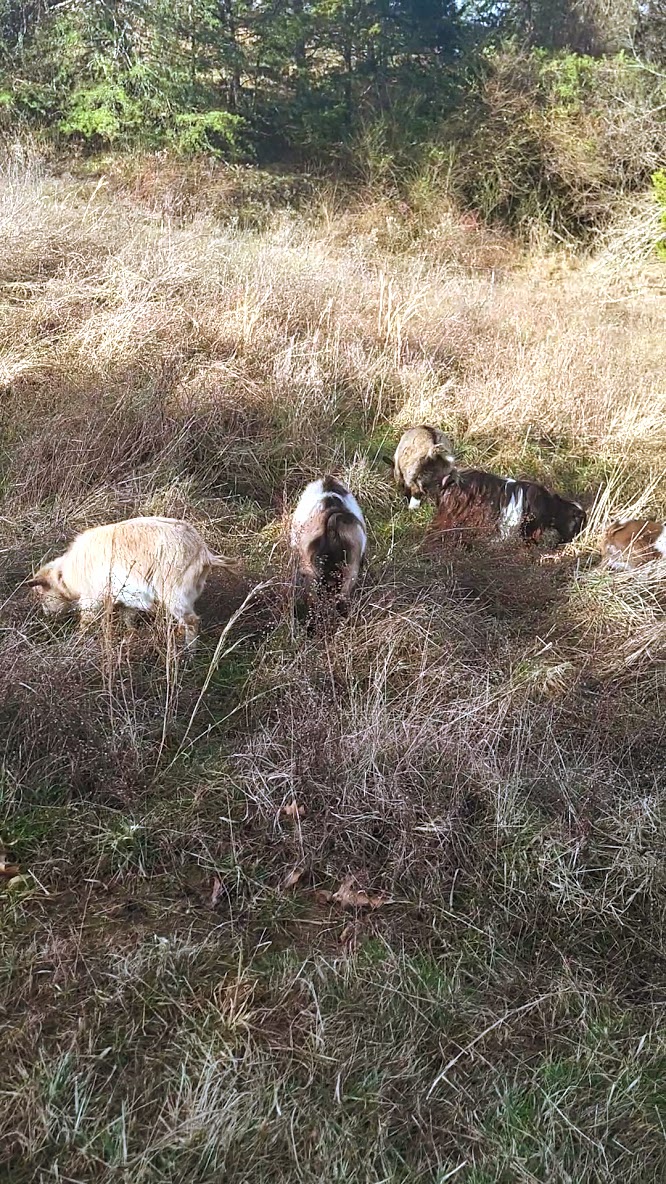A Comparison of Pasture Rotation vs. Continuous Grazing
Do you use pasture rotation with your livestock? Come on a pasture walk with me so you can see the benefits of it! These pictures were taken in February, a time when forage regrowth is still minimal.
Continuous Grazing
The pasture with continuous grazing currently is occupied by 6 doelings and 2 guardian dogs. In October, this pasture had a total of 14 goats, 2 pigs, and the 2 dogs. We have gradually been destocking this pasture in hopes that less grazing pressure would allow for better regrowth. However, we are not seeing that so far. What should we do instead to help this pasture? Well, let’s compare the effects of continuous grazing with pasture rotation!

The first picture is our 2 acre permanently fenced in pasture. In this pasture, we have not been rotating our goats. Currently, the pasture is occupied by 6 doelings and 2 guardian dogs. And just look at the vegetation! There is an entire hillside of broomsedge that the goats refuse to eat. Yet the doelings come down to this corner every afternoon to snack on whatever few millimeters of the little vegetation here has regrown in 24 hours. It’s like this corner of the pasture is the dessert buffet at the all you can eat restaurant and the goats will not let it grow back!
This is what happens to pasture when the livestock are not rotated. They will continue to eat the most delicious tidbits while ignoring other sources of food which may still be nutritious, but just not as palatable. But can you blame them? Wouldn’t your kids eat junk food all day every day if you let them?
Rotational Grazing

Next, we are going across our driveway. Here we rotated the bucks in small pastures along the old fence line. We were using our bucks to help clear out all the overgrowth. Then, we added our breeding-aged does to their herd back in December. The first section of pasture had 2 bucks on it for a month in November. They ate it down to nothing. But since they have been rotated off of it, it has had the opportunity to regrow, unlike the corner of our permanent pasture.
Also note, the lack of broomsedge where the bucks were. I witnessed them eating some of it as their forage options reduced. The rest of it was trampled down because of their frequent movement in the smaller space. This helped break down the broomsedge to allow sunlight to reach the new plants that were growing under it and turn the stems into compost to allow the soil to have carbon added back into it.

The bucks were moved into the second section in this area in December. We did not leave them in this section for quite as long and the grass here has regrown faster than the first section. When using pasture rotation, it is often said to take half, leave half. We have also heard of the 33% model: 33% of forage is eaten, 33% of forage is compacted, and 33% of forage is untouched. While we know these models are best practice, we are still striving towards attaining it and left our animals on pasture too long. This means the pasture will need longer rest before it can be regrazed.

After this section, we divided the goats into 2 breeding groups of 3 goats each for about 7 weeks. They were removed from this pasture just a few days ago and given a new section of pasture to browse. The last picture shows what the pasture looked like at the end of these 7 weeks. During this time, we fed the goats supplemental hay 3 times a week.

How Much Space is Needed for Rotational Grazing?
If you are thinking you do not have enough space to use pasture rotation, I want you to consider our pasture sizes. The original picture of the pasture the 6 doelings are not allowing to regrow is 2 acres. As for the space the 2 bucks and 4 breeding does have been rotated through…it is approximately 1 acre, divided into .20 (or smaller) acre pastures.
Moral of the story? When you use pasture rotation, you allow for vegetation regrowth. Just like how we want the most delicious and easy to eat food every day, so do our livestock. However, the most delicious food isn’t always best for our health. When we let our animals eat it every day, it’s not good for our pasture’s health either. If you think your pasture is too small for pasture rotation, consider the the health of our 2 acre pasture to the 1 acre that has been rotated. When pasture rotation is used you can often increase the stocking density or reduce the amount of supplemental feed, even on a small farm.
